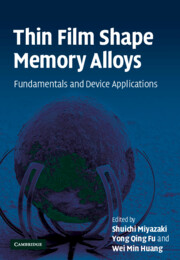Book contents
- Frontmatter
- Contents
- List of contributors
- Preface
- Abstracts of chapters
- 1 Overview of sputter-deposited TiNi based thin films
- 2 Martensitic transformation in TiNi alloys
- 3 Deposition techniques for TiNi thin film
- 4 TiNi multilayer thin films
- 5 Crystallization and microstructural development
- 6 Mechanical properties of TiNi thin films
- 7 Stress and surface morphology evolution
- 8 Ion implantation processing and associated irradiation effects
- 9 Laser post-annealing and theory
- 10 Overview of thin film shape memory alloy applications
- 11 Theory of SMA thin films for microactuators and micropumps
- 12 Binary and ternary alloy film diaphragm microactuators
- 13 TiNi thin film devices
- 14 Shape memory microvalves
- 15 Superelastic thin films and applications for medical devices
- 16 Fabrication and characterization of sputter-deposited TiNi superelastic microtubes
- 17 Thin film shape memory microcage for biological applications
- 18 Shape memory thin film composite microactuators
- 19 TiNi thin film shape memory alloys for optical sensing applications
- Index
2 - Martensitic transformation in TiNi alloys
Published online by Cambridge University Press: 23 February 2010
- Frontmatter
- Contents
- List of contributors
- Preface
- Abstracts of chapters
- 1 Overview of sputter-deposited TiNi based thin films
- 2 Martensitic transformation in TiNi alloys
- 3 Deposition techniques for TiNi thin film
- 4 TiNi multilayer thin films
- 5 Crystallization and microstructural development
- 6 Mechanical properties of TiNi thin films
- 7 Stress and surface morphology evolution
- 8 Ion implantation processing and associated irradiation effects
- 9 Laser post-annealing and theory
- 10 Overview of thin film shape memory alloy applications
- 11 Theory of SMA thin films for microactuators and micropumps
- 12 Binary and ternary alloy film diaphragm microactuators
- 13 TiNi thin film devices
- 14 Shape memory microvalves
- 15 Superelastic thin films and applications for medical devices
- 16 Fabrication and characterization of sputter-deposited TiNi superelastic microtubes
- 17 Thin film shape memory microcage for biological applications
- 18 Shape memory thin film composite microactuators
- 19 TiNi thin film shape memory alloys for optical sensing applications
- Index
Summary
Abstract
The basic characteristics of the martensitic transformation of TiNi shape memory alloys are described. They include the crystal structures of the parent and martensite phases, the recoverable strain associated with the martensitic transformation, the transformation temperatures, the temperature and orientation dependence of deformation behaviour, etc. Shape memory and superelasticity related to the martensitic transformation are also explained.
Introduction
The shape memory effect (SME) and superelasticity (SE) are associated with the crystallographically reversible nature of the martensitic transformation which appears in shape memory alloys (SMAs). Such a crystallographically reversible martensitic transformation has been named “thermoelastic martensitic transformation”. The name originates from the characteristic of the martensitic transformation in shape memory alloys, i.e., the total free energy change associated with the thermoelastic martensitic transformation mainly consists of two thermoelastic terms, chemical free energy and elastic energy, while the total free energy change associated with the conventional martensitic transformation, which appears in steels for instance, consists of the energy of interfaces and plastic deformation in addition to the two thermoelastic terms. Therefore, the interface between transformed and untransformed regions moves smoothly according to the temperature variation so that the transformation temperature hysteresis is small, from several to several tens of degrees K, compared with those of steels that are several hundreds of degrees K. The characteristic that plastic deformation does not occur in the thermoelastic martensitic transformation is one of the necessary factors for the perfect shape recovery upon the reverse transformation in shape memory alloys.
The martensitic transformation itself is not a new phenomenon.
- Type
- Chapter
- Information
- Thin Film Shape Memory AlloysFundamentals and Device Applications, pp. 73 - 87Publisher: Cambridge University PressPrint publication year: 2009
- 1
- Cited by



